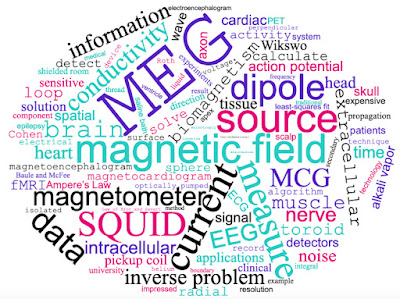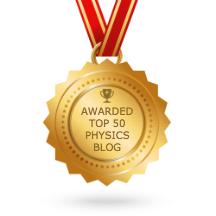Russ Hobbie and I stress qualitative thinking, in addition to quantitative thinking, in Intermediate Physics for Medicine and Biology. What’s the difference? Qualitative thinking is the ability to guess approximately what a solution will look like. As an example, let me share the first part of one of my publications that I always liked. It is from the article “Approximate analytical solutions of the bidomain equations for electrical stimulation of cardiac tissue with curving fibers,” published in Physical Review E (Volume 67, Article number 051925) in 2003. I wrote the paper with my graduate student Debbie Langrill Beaudoin.
In the first paragraph, we wrote “Fig. 1 shows the fiber geometry throughout a sheet of tissue and the direction of the applied electric field. Can you look at Fig. 1 and predict where the tissue will be depolarized and where it will be hyperpolarized?” Figure 1 is shown below.
Warning: Debbie and I cooked up a way to
avoid polarization at the boundaries. Ordinarily you would expect a big
hyperpolarization on the left and a depolarization on the right, both
restricted to only a few length constants from the edge. Ignore this
effect. Just consider the polarization caused by the fiber curvature.
At this point, dear reader, I ask you to stop reading and guess the distribution of polarization. Take a piece of paper, sketch the fiber distribution in Fig. 1, and then mark which areas of the tissue are depolarized and which are hyperpolarized. If you have some colored pencils handy, just color the depolarized region red and the hyperpolarized region blue. Go ahead. I’ll wait...
Okay, let’s see how you did. Below is Fig. 6 of our paper, which gives the result. Depolarization is in red, hyperpolarization is in blue.
Did you get anything like this?
To help explain the polarization distribution, I’ve created two new figures not in the paper. In both, the short gray line segments show the fiber geometry. The purple arrows indicate the direction of the applied electric field. Green shows a component of the intracellular current density. The red D’s and blue H’s indicate depolarization and hyperpolarization. The first of the two figures is shown below, and illustrates what I’ll call “Mechanism 1.”
 |
| Mechanism 1 |
In the region where the fibers point along the applied electric field (like along the left edge of the tissue), the current is divided approximately equally between the intracellular and extracellular spaces because they have similar conductivities in that direction. So, the green intracellular current density arrows are relatively large there. In the region where the fibers point perpendicular to the applied electric field (like in the center), the intracellular current density is less than the extracellular current density because the intracellular conductivity is smaller than the extracellular conductivity in that direction, so the green intracellular current density arrows are relatively small. Somewhere between these two regions current had to leave the intracellular space and pass out through the membrane, entering the extracellular space. This outward membrane current depolarizes the tissue (red D’s). If the fiber direction then changes back to being parallel to the electric field (like along the right edge of the tissue), some extracellular current must recross the membrane and reenter the cell, which hyperpolarizes the tissue (blue H’s). This behavior is shown in the upper small plot to the left of Fig. 6a.
The next new figure illustrates “Mechanism 2.” Consider what happens where the fibers are oriented at an angle of about 45 degrees to the electric field. In that case, even though the electric field may be horizontal the anisotropy rotates the intracellular current density to be more nearly parallel to the fibers (the direction with the highest conductivity). In other words, the electric field is horizontal, but the intracellular current density rotates counterclockwise. The extracellular current density also rotates, but not as much because the intracellular space is more anisotropic than the extracellular space. Thus, you pick up a component of the intracellular current perpendicular to the applied electric field (shown by the green arrows). If the fibers change direction so they are either parallel or perpendicular to the field, you get no rotation of the current density there, so there is no component of the intracellular current perpendicular to the electric field. At the head of one of those green arrows, the intracellular current density vector ends so the intracellular current must cross the membrane and enter the extracellular space, depolarizing the tissue. At the tail of a green arrow the intracellular current density vector begins so the extracellular current must cross the membrane and enter the intracellular space, hyperpolarizing the tissue. This results in a somewhat complicated pattern of polarization (H’s and D’s), which resembles the pattern shown in the lower small plot to the left of Fig. 6a.
 |
| Mechanism 2 |
Both of these mechanisms operate simultaneously, so the net polarization is the sum of those two small plots. This results in the Yin-Yang pattern of depolarization and hyperpolarization of Fig. 6a. (Stare at Fig. 6a long enough until you realize this is correct.) Below it, in Fig. 6b, is the result you get if you just mindlessly solve the bidomain equations numerically. (Actually, Debbie solved them, and she did nothing mindlessly, but you know what I mean).
The two are qualitatively the same, although there are quantitative differences.
So, how many of you guessed the Yin-Yang pattern? To tell you the truth, I’m not sure I did when Debbie and I first started this analysis. It’s difficult. But at least now I have a way to understand this pretty but nonintuitive pattern. I’ve found that being able to do these hand-waving types of explanations is useful. It lets you understand what is going on, rather than just putting a calculation into a black-box computer program and getting out an answer with no insight. Remember: the purpose of computing is insight, not numbers!
Finally, I really enjoyed starting a research paper off with a puzzle like that in Fig. 1 and ending it with the solution like in Fig. 6. I think you should consider using this trick in your next article.





























